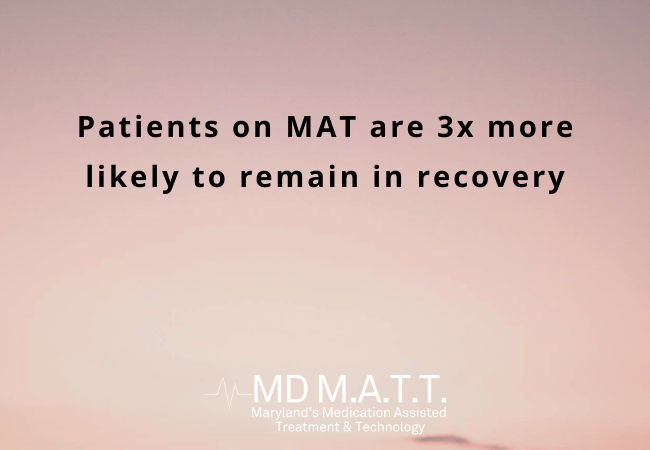The opioid epidemic has gripped the United States for over two decades, devastating communities, overwhelming healthcare systems, and taking hundreds of thousands of lives. In Maryland alone, the crisis has intensified in recent years due to the rise of fentanyl and other synthetic opioids, making intervention more urgent than ever.
While no single solution can end this crisis overnight, Medication-Assisted Treatment (MAT) has proven to be one of the most effective tools in helping individuals break free from opioid addiction and avoid overdose. At MD M.A.T.T., a trusted Medication-Assisted Treatment Center in Maryland, we believe MAT isn’t just important—it’s essential.
Understanding the Severity of the Opioid Epidemic
- Over 80,000 opioid overdose deaths occurred in the U.S. in 2023 alone
- More than 2.5 million people currently struggle with opioid use disorder (OUD)
- In Maryland, opioid-related deaths increased by nearly 400% between 2010 and 2020
- Fentanyl is now involved in more than 90% of opioid overdose deaths in the state
(Sources: CDC, Maryland Department of Health, NIDA)
Despite the scale of the crisis, only 1 in 4 people with OUD receive any form of treatment—and even fewer have access to MAT, which is proven to cut the risk of fatal overdose in half.
What is Medication-Assisted Treatment (MAT)?
Medication-Assisted Treatment combines FDA-approved medications—like Suboxone, Methadone, and Naltrexone—with counseling, behavioral therapies, and long-term support. It’s not just about managing symptoms—it’s about treating the whole person.
Common MAT Medications:
-
Suboxone (buprenorphine + naloxone): Reduces cravings and blocks euphoric effects of opioids.
-
Methadone: Long-acting opioid agonist that stabilizes individuals with severe dependency.
-
Naltrexone (Vivitrol): Opioid blocker that helps prevent relapse once detox is complete.
At our Suboxone Treatment Clinic in Maryland, we specialize in buprenorphine-based MAT, which allows patients to receive effective treatment in an outpatient setting without disrupting daily life.
Why MAT Is So Effective: The Science Behind It
1. Eases Withdrawal and Cravings
Medications like Suboxone help manage painful withdrawal symptoms, which are one of the biggest barriers to recovery. By making detox more tolerable, MAT gives individuals a fighting chance to stay in treatment.
2. Normalizes Brain Function
Opioid use damages the brain’s reward system. MAT medications restore chemical balance, helping people think clearly, manage emotions, and participate in therapy effectively.
3. Reduces Relapse and Overdose
Patients receiving MAT are:
- 50% less likely to die from an overdose
- 2x more likely to remain in treatment
- Far less likely to relapse, especially in early recovery
(Sources: SAMHSA, NIDA)
4. Supports Long-Term Recovery
By reducing cravings and stabilizing patients, MAT allows for better engagement in therapy, employment, relationships, and overall life improvement.
The Role of Suboxone in the Fight Against Opioids
Suboxone is one of the most commonly used medications in MAT due to its safety profile and accessibility. At MD M.A.T.T.’s Suboxone Treatment Clinic in Maryland, we provide:
-
Same-day inductions when appropriate
-
Flexible outpatient scheduling
-
Telehealth options for follow-up care
-
Individualized dosing and care plans
-
Integrated counseling and mental health support
With its partial agonist properties, Suboxone provides enough opioid receptor stimulation to prevent withdrawal, without producing a euphoric effect. This reduces the potential for misuse while offering a path to stabilization and recovery.
Suboxone: The MAT Leader in Outpatient Recovery
At MD M.A.T.T.’s Suboxone Treatment Clinic in Maryland, we specialize in Suboxone-based care due to its unique ability to combine safety, effectiveness, and accessibility.
What makes Suboxone ideal?
- Buprenorphine: Reduces cravings and withdrawal symptoms
- Naloxone: Prevents misuse by triggering withdrawal if injected
- Ceiling effect: Limits euphoria and overdose risk even at high doses
- Outpatient-friendly: Allows patients to continue work, parenting, or school
This makes Suboxone ideal for individuals who want to recover without putting their lives on hold—something we prioritize through our flexible outpatient MAT services.
MAT Is Not “Trading One Drug for Another”—Here’s Why That’s a Harmful Myth
One of the most common and dangerous misconceptions about MAT is that it simply substitutes one addiction for another. This myth causes many people to avoid or prematurely stop treatment—sometimes with fatal consequences.
The truth:
- MAT medications are non-euphoric when taken as prescribed
- They are prescribed and monitored by licensed medical professionals
- They restore, not replace, normal function
Addiction is a chronic condition, and like insulin for diabetes or medication for high blood pressure, MAT offers long-term disease management—not substitution.
The Broader Impact of MAT: Public Health Benefits
Reduces Community Overdose Rates
Regions with high MAT access report significantly lower overdose death rates. This includes Baltimore and other areas of Maryland where MAT expansion has saved lives.
Decreases Healthcare Burden
MAT reduces ER visits, hospital admissions, and emergency interventions—saving the healthcare system billions annually.
Improves Employment and Stability
Individuals on MAT are more likely to gain and maintain employment, achieve housing stability, and rebuild family and community ties.
Helps Address Mental Health
MAT programs often include dual diagnosis care, allowing individuals to treat co-occurring disorders like anxiety, PTSD, or depression alongside addiction.
Why Stigma Around MAT Still Exists—And Needs to End
Despite being backed by science, MAT is still surrounded by myths:
-
“You’re just replacing one drug with another.”
-
“People on MAT aren’t really sober.”
-
“It’s not real recovery.”
These harmful misconceptions lead to:
-
Delayed treatment
-
Higher overdose rates
-
Emotional and social isolation
At MD M.A.T.T., we are actively working to break this stigma by educating families, communities, and healthcare professionals about the lifesaving power of MAT.

Why Access Matters: The MAT Treatment Gap
Despite its success, access to MAT remains limited—especially among marginalized groups. Common barriers include:
- Lack of local providers
- Stigma from employers or loved ones
- Misinformation about treatment
- Financial limitations or lack of insurance
At MD M.A.T.T., we are actively working to close this gap by offering:
- Same-day appointments
- Insurance acceptance and self-pay plans
- Telehealth and evening/weekend hours
- Culturally competent and inclusive care
What to Expect from MAT at MD M.A.T.T.
As a full-service Medication-Assisted Treatment Center in Maryland, we offer a compassionate, client-centered recovery experience, including:
- Suboxone induction and management
- Mental health and trauma counseling
- Family therapy and relapse prevention
- Ongoing case management
- Aftercare and long-term support planning
Every treatment plan is customized to the individual—and supported by an expert team of addiction specialists.
Conclusion
The opioid epidemic is complex—but effective solutions do exist. Medication-Assisted Treatment is not only backed by science, it’s backed by lives changed.
At MD M.A.T.T., we are on the front lines of this crisis—offering individualized care, community education, and unwavering support. If you or a loved one is struggling with opioid addiction, MAT could be the key to not just survival, but real, sustained recovery. Call us today at 410.364.8194 to schedule your confidential consultation. Together, we can fight the epidemic—one life, one treatment, one success story at a time.
Frequently Asked Questions (FAQ)
How does Medication-Assisted Treatment (MAT) help fight the opioid epidemic?
MAT combines FDA-approved medications like Suboxone with therapy and long-term support to reduce cravings, prevent relapse, and lower overdose deaths. It treats addiction as a chronic medical condition, making it more manageable and sustainable.
Why is Suboxone often used in MAT programs?
Suboxone contains buprenorphine and naloxone. It reduces withdrawal symptoms and cravings without producing a high and includes safeguards against misuse, making it a safe and effective outpatient treatment option.
Is MAT just replacing one drug with another?
No. When taken as prescribed, MAT medications do not produce a euphoric effect. They stabilize brain chemistry and support recovery. Comparing MAT to drug use is a harmful myth that deters many from seeking help.
How effective is MAT compared to abstinence-only programs?
Studies show MAT reduces the risk of opioid overdose by up to 59% and doubles or even triples retention in treatment programs compared to abstinence-only models.
Is MAT available in an outpatient setting?
Yes. At MD M.A.T.T., our Suboxone Treatment Clinic in Maryland offers flexible outpatient services, allowing patients to continue working, parenting, or attending school while receiving care.
Can MAT help with fentanyl addiction?
Absolutely. MAT is effective in treating opioid use disorder, including fentanyl dependence. Suboxone helps block fentanyl’s effects and reduces cravings, making it a powerful tool in fentanyl-related overdose prevention.



